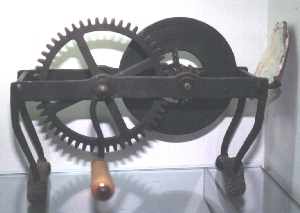
Mining Memorabilia - Miners Lamps (Part III)
Naked Flame Lamps - Prior to the introduction of specially designed forms of miners' lamps the tallow candle was the principle type of mine illumination. This continued to be the case in most metalliferous mines and none "gassy" collieries (where explosive gases were rarely a problem) for many centuries until the introduction of higher luminosity forms of lighting.
The methods of carrying or supporting such candles varied considerably between the mining regions. Some common methods included;
Affixing the candle to the miner's hat via the use of a soft ball of clay.
Affixing the candle to a wooden pit prop adjacent to the miner's work place using a simple spiked candle holder.
Enclosing the candle in a simple hand held tin box with a shrouded canopy (i.e. the so called "midgie" lamp).
Prior to the introduction of the flame safety lamp into collieries there had been little improvement in the safety aspects of mine lighting with the exception of the "Steel or Flint Mill". This simple device was the invention of Carlyle Spedding. Spedding was the principle colliery agent for the Lowther family's Whitehaven Collieries. These mines were notoriously "gassy" and were commonly known as "the most dangerous pits in all the kingdom".

Carlyle Spedding's "Steel or Flint Mill".
Although Spedding's invention was not intrinsically safe it was less dangerous option to the use of a naked candle. Writing nearly 80 year after the first introduction of the steel mill (c.1730) one eminent British mining engineer described it as follows;
"An instrument for striking light with flint and steel. A brass wheel about 5 inches in diameter, with 52 teeth, works a pinion with 11 teeth. On the axle on the latter is fixed a thin steel wheel from 5 inches to 6 inches in diameter. The wheels are placed in a light frame of iron which is suspended by a leather belt round the neck of the person who plays the mill. Great velocity is given to the steel wheel by turning the handle of the toothed wheel, and the sharp edge of a flint is applied to the circumference of the steel wheel, which immediately elicits an abundance of sparks, and emits considerable light."
Like the flame of safety lamp the sparks emitted by the Steel Mill changed in colour as the levels of methane in the surrounding mine gasses increased. This at least afforded the miner some form of warning.
By 1800 some copper miners in Cornwall were experimenting with simple ceramic type "Tea Pot" lamps. Such lamps consisted of an oil storage reservoir (complete with lid) with a spout through which a woollen wick was pushed. Such lamps burnt both oil and tallow fuels and were small enough to be worn on the miners' hats in place of their traditional candles. By 1850 Scottish colliers working in none "gassy" mines were beginning to use similar oil wick lamps made of tin or brass.

A Scottish Colliers oil wick lamp c.1860-1900.
The oil wick lamp was to become very popular in Scotland and the use of such spout lamps was to continue in many places well into the 1900s.
In the Welsh anthracite coalfields a slightly different oil cap lamp was to become popular around the turn of the twentieth century. This lamp was commonly know as a "Peg & Ball Lamp" and consisted of a bulbous tin or brass oil reservoir with wick that screwed onto a hollow tin spike which fastened onto the miner's cap.
By the mid 1890s yet another form of naked flame miners light was to appear. This new device, the carbide lamp, produced extremely good illumination and was soon to become the standard form of miners light in most metalliferous mining regions replacing the use of candles and oil wick lamps. Such lamps were also to become popular in none "gassy" collieries and especially the anthracite pits of South Wales. The use of carbide lamps in many collieries continued well into the post nationalization era (i.e. after 1947).

A Premier carbide hand lamp & a Belcor No.1 carbide cap Lamp. Both 1930s.